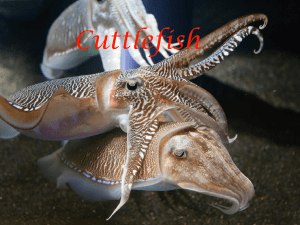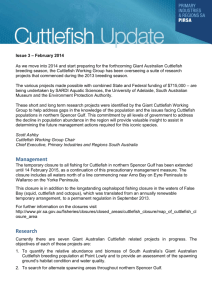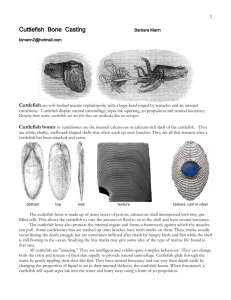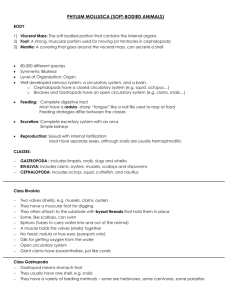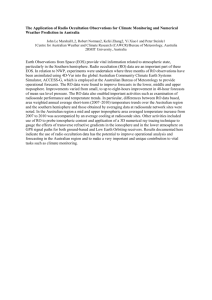Issue 4 – July 2014 With the 2014 Giant Australian Cuttlefish
advertisement
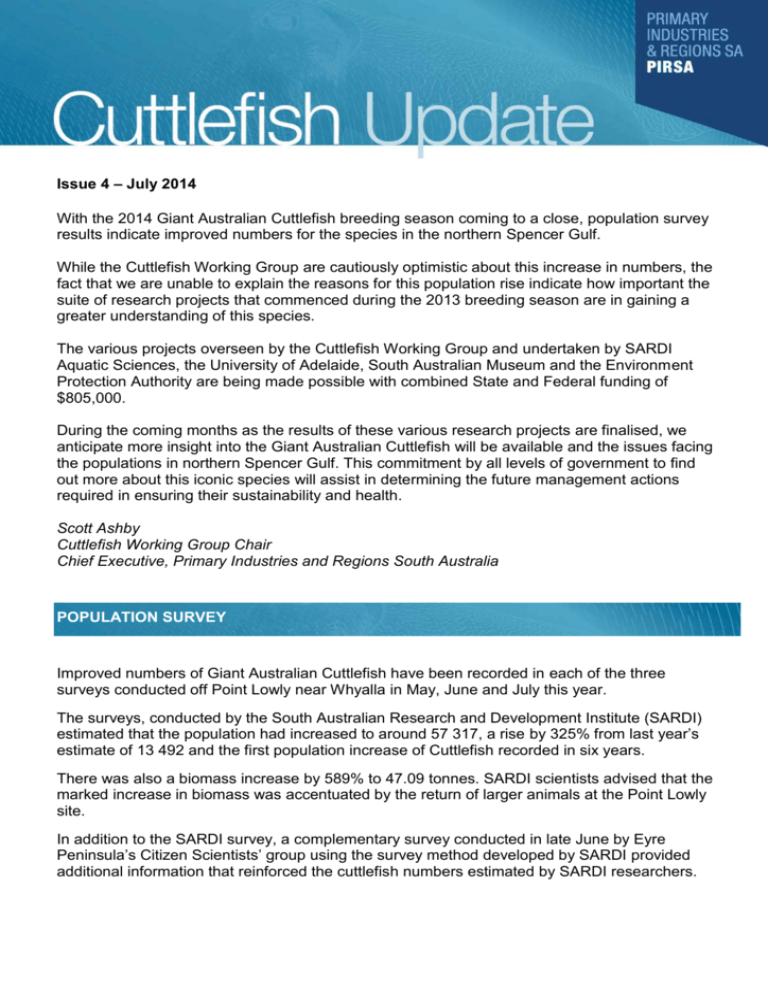
Issue 4 – July 2014 With the 2014 Giant Australian Cuttlefish breeding season coming to a close, population survey results indicate improved numbers for the species in the northern Spencer Gulf. While the Cuttlefish Working Group are cautiously optimistic about this increase in numbers, the fact that we are unable to explain the reasons for this population rise indicate how important the suite of research projects that commenced during the 2013 breeding season are in gaining a greater understanding of this species. The various projects overseen by the Cuttlefish Working Group and undertaken by SARDI Aquatic Sciences, the University of Adelaide, South Australian Museum and the Environment Protection Authority are being made possible with combined State and Federal funding of $805,000. During the coming months as the results of these various research projects are finalised, we anticipate more insight into the Giant Australian Cuttlefish will be available and the issues facing the populations in northern Spencer Gulf. This commitment by all levels of government to find out more about this iconic species will assist in determining the future management actions required in ensuring their sustainability and health. Scott Ashby Cuttlefish Working Group Chair Chief Executive, Primary Industries and Regions South Australia POPULATION SURVEY Improved numbers of Giant Australian Cuttlefish have been recorded in each of the three surveys conducted off Point Lowly near Whyalla in May, June and July this year. The surveys, conducted by the South Australian Research and Development Institute (SARDI) estimated that the population had increased to around 57 317, a rise by 325% from last year’s estimate of 13 492 and the first population increase of Cuttlefish recorded in six years. There was also a biomass increase by 589% to 47.09 tonnes. SARDI scientists advised that the marked increase in biomass was accentuated by the return of larger animals at the Point Lowly site. In addition to the SARDI survey, a complementary survey conducted in late June by Eyre Peninsula’s Citizen Scientists’ group using the survey method developed by SARDI provided additional information that reinforced the cuttlefish numbers estimated by SARDI researchers. SARDI undertakes the surveys annually throughout the peak spawning season in May, June and July. The surveys routinely monitor ten key sites around the Point Lowly peninsula recording cuttlefish numbers, as well as their size, sex, habitat condition and water quality. RESEARCH Currently there are seven Giant Australian Cuttlefish related projects with one recently completed. All final reports from these projects will be finalised by early 2015. The objectives of each of these projects are: 1. To quantify the relative abundance and biomass of South Australia’s Giant Australian Cuttlefish breeding population at Point Lowly and to provide an assessment of the spawning ground’s habitat condition and water quality (see 2014 results above). 2. To search for alternate spawning areas throughout northern Spencer Gulf. 3. To characterise the natural spawning substrate with the intention of using this information to design and develop artificial habitat that may promote spawning in areas where habitat is limited. 4. To assess whether there are abnormally high levels of metals accumulating in Giant Australian Cuttlefish in northern Spencer Gulf. 5. To quantify cuttlefish by-catch in the commercial fishing sector. 6. To determine the movement and fine scale population structure of Giant Australian Cuttlefish in northern Spencer Gulf. 7. To investigate the potential impacts of shipping on Giant Australian Cuttlefish. RESEARCH PROGRESS Artificial habitat project The sub-tidal rocky reef fringing from Black Point to Point Lowly is unique in northern Spencer Gulf and its structure along with its west to east aspect. The plate-like fragmented slabs of bedrock that comprise the reef create numerous dens and crevices in which the female cuttlefish attach their eggs. These dens are vital for successful reproduction and recruitment as they provide both a stable structure for egg attachment and a refuge for hatchlings. During the 2013 spawning season the dimensions of the natural dens were measured (width, height and depth), along with determining the number of entrances, their orientation, the substrate type, the water depth they were located in and the number of eggs present. Analysis of the natural dens enabled researchers to design artificial dens which were deployed at five northern Spencer Gulf sites in March 2014. Preliminary observations by SARDI scientists indicate that the structures are accommodating cuttlefish on the main spawning grounds (Black Point), however, it is not known whether they are supporting any eggs at this stage. The Conservation Council SA and Reef Watch volunteers will be monitoring the habitat in August and will be supported by external funding from Australian Geographic. Bioaccumulation of Heavy Metals In 2013, the Environment Protection Authority undertook a study to investigate whether there are abnormally high levels of metals accumulating in Giant Australian Cuttlefish and if these levels are replicated in another local cephalopod species, Southern Calamari, which has not had a comparable population decline. A report on the research has now been peer reviewed with results indicating that there seems to be nothing remarkable in the metal burden of the Giant Australian Cuttlefish to indicate it as a contributing factor in population decline. The results were also clear that any metal burden found in the mantle of both the Giant Australian Cuttlefish and Southern Calamari were well below food safety standards, confirming them safe to eat. The report is currently being finalised for release later this year. Cuttlefish By-Catch Monitoring programs to quantify cuttlefish by-catch in South Australia’s Spencer Gulf Prawn fishery were conducted during the 2013-14 fishing season in partnership with industry. SARDI is currently processing collected samples. Fine-Scale Population Structure This project is led by the University of Adelaide in collaboration with SARDI and the South Australian Museum and is funded by the Fisheries Research and Development Corporation (FRDC). This two year project commenced in March 2013 and aims to: a. Determine the movement throughout the life history and finer-scale population structure of the Giant Australian Cuttlefish in northern Spencer Gulf. b. Resolve the taxonomic status of Giant Australian Cuttlefish to determine the extent of its geographic boundaries. c. Develop an integrated model that assesses and evaluates the response of the northern Spencer Gulf population to environmental and anthropogenic factors, thereby assessing population viability. Preliminary genetic data confirms the population break around Wallaroo, with further work required to determine the boundary of the upper Spencer Gulf population and if it is a separate species. Scientists indicate that it is still too early in the research to indicate if this is the case. Impacts of Shipping This project, now completed, was led by the University of Adelaide in collaboration with SARDI and EPA and was funded by the Department of the Environment. It included a desktop review of cuttlefish research to date and an investigation on the potential impacts of shipping on cuttlefish. Two laboratory projects, one investigating the effects of various shipping noise and turbidity levels on the development of Giant Australian Cuttlefish embryos and the other on the effects of shipping noise on adults have been completed. Results indicated that: Shipping noise and turbidity had no significant effect on hatching success although only one component of shipping noise was assessed. The size of hatchlings was not unaffected by shipping noise. Turbidity had no significant effect on hatching success or embryonic development. Shipping noise also had no effect on the metabolic rate of adult Giant Australian Cuttlefish. The full report is now available from the Commonwealth Department of the Environment website: http://www.environment.gov.au/sustainability/publications/investigating-potentialimpacts-shipping-giant-australian-cuttlefish Management The temporary closure to all fishing for the Great Australian Cuttlefish in northern Spencer Gulf has been extended until 14 February 2015. The closure includes all waters north of a line commencing near Arno Bay on Eyre Peninsula to Wallaroo on the Yorke Peninsula. This closure is in addition to the longstanding cephalopod fishing closure in the waters of False Bay (squid, cuttlefish and octopus), which was translated from an annually renewable temporary arrangement, to a permanent regulation in September 2013. For further information on the closures visit http://www.pir.sa.gov.au/fisheries/closures/closed_areas/cuttlefish_closure/map_of_cuttlefish_cl osure_area Redmap As part of the FRDC project investigating movement patterns and population structure of the Giant Australian Cuttlefish, fishers, SCUBA divers, boaters and other marine users are being asked to assist by reporting any sightings of Cuttlefish aggregations (groups of more than 10 Cuttlefish) and their eggs via www.redmap.org.au Information from the public will also help determine if this species is breeding outside Point Lowly. Photos can also be uploaded to the site, enabling scientists to verify the sighting. For more information visit the Redmap website Sightings of Giant Australian Cuttlefish (or cuttlefish eggs) can also be reported online to the Reef Watch Feral or in Peril Program run by the Conservation Council SA. You will need to register to use the system and then go through the Field Guide to make your report. Subscribe To join the Cuttlefish Update mailing list email fontella.koleff2@sa.gov.au with the Subject heading ‘Cuttlefish Update Subscription’. The publication can also be viewed at www.pir.sa.gov.au/cuttlefish To unsubscribe email fontella.koleff2@sa.gov.au with the Subject heading ‘Cuttlefish Update Unsubscribe’.
